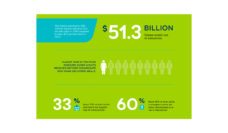As the population ages, older adult malnutrition is becoming a crisis in America. Estimates are that the cost of disease-associated malnutrition in older adults is $51.3 billion per year, and up to one out of every two older adults are at risk of becoming malnourished.
What Is Malnutrition?
Malnutrition, simply stated, is the lack of proper nutrients for one to function. It’s an imbalance of protein, calories, or other vitamins or minerals that negatively impacts a person’s body mass, functions, and/or ultimate clinical outcomes. Malnutrition is particularly hard on older adults because we naturally lose lean body mass as we age; therefore, losing more of it due to malnourishment leaves older adults very vulnerable. Malnutrition can lead to increased fall risk, slower recovery times, re-hospitalizations and readmissions, and death.
Malnutrition in older adults can be caused by a variety of factors, including loss of appetite, lack of ability to chew and swallow, and increased use of prescription medications. Other risk factors include depression, dementia, chronic diseases, and lack of access to optimally nutritious food, whether due to food insecurity or lack of ability to prepare and/or shop for food.
Can We Prevent Malnutrition?
Malnutrition is very preventable. Through screening, assessment, diagnosis, and intervention, malnutrition can be stopped in its tracks and treated—and we can intervene on behalf of those at risk as well.
However, older adult malnutrition is not currently being widely addressed by the American healthcare system. Many physicians and nurses receive no training on older adult malnutrition and little training on nutrition generally during their studies, and there is a general lack of access to registered dietitians throughout the healthcare system. Most people are unaware of the significance of malnutrition as an issue, and though there are widely available screening and diagnostics tools, they are not being used.
The U.S. federal government is no better—though malnutrition has been recognized as a problem by the Centers for Medicare and Medicaid Services (CMS), it has not been included in U.S. national health objectives nor has it been integrated into the CMS quality measures, which are used to help improve facilities’ treatment of patients generally, and in some cases to determine reimbursement levels for the hospitals and doctors who report these measures. The Academy of Nutrition and Dietetics and Avalere Health submitted quality measures to CMS for inclusion in 2018’s Hospital Inpatient Quality Reporting Program, but they were not accepted by CMS in their final rule.
Most people are unaware of the significance of malnutrition as an issue, and though there are widely available screening and diagnostics tools, they are not being used.
So What Do We Do?
Malnutrition, and particularly older adult malnutrition, is complex, and older adults, families, caregivers, communities, organizations, and government entities need to work together to address this issue. Several groups have formed, including Defeat Malnutrition Today, a coalition of over 60 national, state and local groups that advocates on behalf of older adult malnutrition as a serious health risk.
This coalition joined with Avalere to form the Malnutrition Quality Collaborative in September 2016, which created the National Blueprint: Achieving Quality Malnutrition Care for Older Adults. Released in March 2017, it outlines strategies to promote malnutrition care across the continuum of care, and it lists strategies for these stakeholders to consider when combatting older adult malnutrition.
Malnutrition action is also happening at the state level. Ohio and Massachusetts have formed commissions to study the issue of older adult malnutrition and make recommendations to their State Legislatures for action, and Virginia has added the issue of malnutrition to its standing Commonwealth Council on Aging’s list of topics to address. Other states have in the past passed resolutions recognizing older adult malnutrition as an issue and/or to recognize Malnutrition Awareness Week.
Local efforts to address malnutrition include providing meals at senior centers and providing Meals on Wheels and other home-delivered meals. Further, the senior meals programs funded by the Older Americans Act (that is, most local programs) all use the DETERMINE checklist to check for nutritional risk; they also provide nutrition counseling and referrals to dietitians.
Conclusions
Malnutrition is a clear threat to our nation’s older adults. Further, in an era of healthcare priorities focused around prevention, wellness, patient-centered strategies, and proper care transitions, making a concerted effort to address older adult malnutrition fits.
Further, it’s easy to become malnourished; it’s harder to recover. To truly promote “healthy aging,” we must stop this problem as well as prevent it from happening in the first place. Good nutrition throughout the lifespan is key for prevention, and early detection through routine screening provides the best possible outcomes. We must align our nutrition programs, social services, and healthcare providers to address malnutrition in the aging population—as well as educate older adults and their families about this epidemic.
Feature image: Amadeusz Jasak, Untitled, used under CC BY 2.0













